Arriving in Santiago for the first time is thrilling: from the plane the Andes rear up but faintly, as though behind a scrim. You expect the curtain to rise any moment, then it does, and there is the city, cupped and tucked beneath the massive mountains. I would decribe central Santiago’s architecture as “tropical Communist”: great concrete blocks, often enlivened by decorative electrical wiring. Or so it appears. Even in the wealthier business and residential areas, streets sport prominent electrical gear: large, complex arrangements of poles, transformers, and miles of multiple-strand wiring. These lianas of electrical circuitry loop erratically, often precariously, like some sort of living organism, around and above everything in sight. Truly extraordinary.
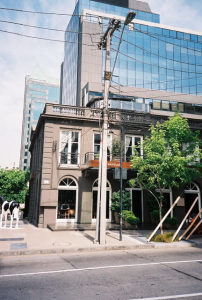 A European city circa 1955 with streets such as the ones I remember from my childhood in Berlin exists within the sleek, new Santiago. Tiny shops crowded cheek by jowl into galeria formation around a plant-happy courtyard. Hair salons and tailors predominate. There are even hairdressers specifically for children-the quaint-sounding peluqueria infantil-where adorable Chilean ni–os and ni–as sit astride wooden giraffes and ponies.
A European city circa 1955 with streets such as the ones I remember from my childhood in Berlin exists within the sleek, new Santiago. Tiny shops crowded cheek by jowl into galeria formation around a plant-happy courtyard. Hair salons and tailors predominate. There are even hairdressers specifically for children-the quaint-sounding peluqueria infantil-where adorable Chilean ni–os and ni–as sit astride wooden giraffes and ponies.
It is incredibly clean everywhere. Even in the poorer parts of town where graffiti adorn crumbling cement walls and houses are dilapidated, the streets and gutters are free of trash. Everywhere, even on weekends, platoons of uniformed LimChile (Limpia=clean) workers roam the streets and plazas. Impressive.
Less impressive is the airport, which is large, brisk, and inefficient. We had been told that first-time American travelers would be charged a $100 entry visa fee. Fine. After standing in a long line for passport control, I arrived at the window clutching my $100 in a choice of cash or traveler cheque(s) only to be sent back through the throngs of people to pay the fee at an unmarked window. Of course this happened again and again to other U.S. arrrivals. So, ET travelers to Chile: at the bottom of the escalator, before getting into line at Immigration, turn left and go to the window next to Cambio (there is only one), pay your $100, then get in line. One more thing: this entry visa is good for the life of the passport.

The Ritz in Santiago
If it’s your first trip to Chile you will want to seriously consider the Ritz: its comfort and efficiency are worth the $220-300 rates. The Ritz will send a car and driver for $60 or you can take a regular cab into the city for $30 but you MUST arrange the $30 fare before getting into the cab. That is the established price for those in the knowÉit will be honored (you have shown that you know the score), but if you fail to mention the $30, the driver will feel entitled to charge you whatever he wants. This strikes everyone as quite fair and equitable.
As always, don’t change money at your hotel or at a bank; find a Casa de Cambio for the best rates. If you are staying at the Ritz, walk down five blocks to the Avda. El Bosque Norte, turn right, and you will find one across the street near the corner which is open not only Mon-Fri 9-6 but also Saturdays 10-2. For a better exchange rate everywhere in Chile, bring cash rather than travelers cheques. [editor’s note: Your ATM card will work at foreign ATMs, the exchange rate is equitable and the convenience unsurpassed.]
Unless you have a huge appetite upon rising, you might want to skip the Ritzy breakfast buffet ($25!) and walk a few blocks to Café Melba on Don Carlos. Here you’ll find good coffee and breakfast pastries at reasonable rates in a non-stuffy atmosphere. Café Melba’s owner, Aucklander Dell Taylor, also owns Akarana in the square next to the Ritz. This must-visit restaurant is in a charming house built in 1945 and recently converted with all the traditional elegance still intact but boasting state-of-the-art lighting and sound baffling. The Kiwi/Chilean fusion food is imaginative and interesting, yet not so over the top that your palate feels it’s at a costume ball. The big experience for me here was eating the first spring rolls I’ve ever enjoyed in my life: “Asian Sensation” is their most appropriate name on the menu. Outstanding.
The other local must is a meal at Donde Augusto in Santiago’s Mercado Central (central market), a beautiful iron-work affair designed by August Eiffel of Eiffel Tower fame: here you will sit-practically in the lap of your neighbor-side by side with middle-class Chileans out for a fabulous lunch of fresh, really fresh, seafood.
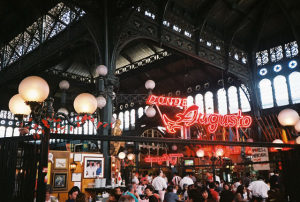
The Eiffel designed Central Market of Santiago
Try the pastel de jaiba, a crab pie of extraordinary flavor and delicacy. The menus are endearingly and creatively translated into English and GermanÉjust pick a fish you like and go with it. A word of caution, especially if your are alone: hawkers with loud voices and insistent hand-waving will try to attract you to their stalls. They won’t actually touch you but the onslaught, if you are unprepared, can be a bit overwhelming. Now that you know to expect this, it can become part of the ambient charm!
Chile is blessed with ideal climatic conditions for grape-growing. Fertile valleys framed by the Andes on one side and the Pacific on the other experience hot summer days followed by very cool nights, allowing the grapes to rest and synthesize the sugars formed during the day. The notable absence of phylloxera has also contributed to the vigor of the Chilean vineyards. This plague, which decimated European vineyards in the 19th century and Napa Valley in the 1990’s, never took hold here, perhaps due to the etxraordinary natural protection afforded by the Chilean topography: the Atacama desert in the north, the Antarctic ice shield to the south, the Andean mountain border to the east, and the Pacific Ocean to the west. Vines therefore have a longer productive life and cloning can be done on original rootstock without grafts. In fact, attacks of fungus and virus, even mildew and botrytis (unless induced), that affect viticulture elsewhere on the planet are unknown anywhere in Chile.
The other ideal factor here is great luminosity due to the absence of rainy or even cloudy days throughout the growth and maturation phases. “Nowadays, we know that light, and not high temperatures, is what forms varietal aromas and color,” says Miguel Torres. Daily highs of 30-35 C. are not uncommon, alternating with nightime lows of 12-15 C. as massive drafts of cold air swoop down from the Andes.
Vigorous vines are an obvious result of the thermal and pest-free conditions; one can find 100 year-old vines which produce very low yields. These gnarled monsters are fabulous to behold, and equally fabulous in the wines they yield. One of my favorites in the old-vine category is the Miguel Torres 2001 Manso de Velasco, a soft yet springy Cabernet Sauvignon for which the phrase “aging gracefully” applies fully. With notes of toffee and bay leaf, this stunner is named for a former governor of Chile. At c. $30 this is an elegant, majestic cab whose ripe fruit stands up beautifully in its tannin corset.
Another favorite at Miguel Torres is their 2005 Santa Digna “Seleccion” Cabernet Sauvignon Rosé. At $10 a bottle this is one of my hot picks: great balance of acidity to fruit with just enough sweetness to tame the tart background. This little wine is fresh and balanced with a dense, delicious aromaÉtruly a beauty at the price.
And finally, from Miguel Torres, another hot pick: the 2004 Santa Digna Merlot. Oak aging (6 months) makes this Merlot’s black fruit mellow and soft. Result: terrific mouthfeel with a lovely liquorice finish. At $12, this is one of the best Merlots I’ve ever encountered in this price range. Bravo!
Premium wines in the mid-range category could be the mantra for what I found at every winery I visited. Price is in fact one of the key factors that allows the emerging Chilean wine industry to be so competitive: optimal growing conditions on land that costs a fraction of what it would elsewhere in the world. But things were not always thus, in fact, Chile’s emergence on the world wine stage is relatively recent. Wine had always been popular here, perhaps a little too popular. To cope with the rampant alcoholism which had become a national problem during the 20’s and 30’s, Chile introduced its own form of Prohibition in 1939. “No new planting was permitted-not even replanting of dead or diseased vines-and very heavy taxes were imposed to bring the wine industry to a virtual standstill,” says Mercedes Espinola of Errázuriz . Such was the situation until the late 1970’s when Miguel Torres, from a noted Spanish wine dynasty, moved to Chile and opened a winery in the Curico Valley. This paved the way for other winemakers, for changes in the law, for the a now booming fine-wine industry which is, amazingly, only 20 years old.
There are nine wine-growing valleys in Chile, some with one or two wineries, some with as many as twenty. Most wineries own land in several valleys to optimize the climatic conditions for each varietal. In a future article Epicurean Traveler will lay out a wine travel itinerary with places to eat and stayÉactual wine tourism as we usually do it. For now we will concentrate on several of the wineries closest to Santiago. Do take the subway if you can: for 60 cents you can ride virtually anywhere and, given the amount of street construction, this is a Good Idea.
CONCHA Y TORO
By far the largest operation, with 25 winemakers and 60 thousand visitors per year, C&Y is the granddaddy of Chilean wineries with continuous tours and the only on-site wine bar in the country. (By the time this article appears, there will be several moreÉwine tourism is increasing rapidly.) C&Y lies on the outskirts of Santiago, and can/should be reached by metro (Puente Alto). You do not want to attempt the journey overland: street construction in this area means serious delays.
The new wine bar is quite fine: sleek yet comfortable built-ins designed by Francisco Monjes with ceilings of rauli, a Chilean wood traditionally used to age wine before barrels were imported. It reminded me of my local CA redwoods. P.S. If you are a sommelier, write to droman@conchaytoro.cl so that Dennis Roman can put together a special tasting for you.
C&Y has 8 lines or ranges of wine: something for every palate and pocketbook. I was particularly taken with the 2004 Marques de Casa Concha Syrah for $15. This 93% Syrah/ 7% Carmenère blend is a steal at this price. The rich bacon/boysenberry flavor produces a dynamic mouthfeel despite its velvety softness. Low yields (c.3 tons per acre) and no fining are the key. This is a new wine: the 2004 is the first vintage with a production of only two thousand cases. Next year there will be four, in 2007 seven thousand. Get some!
Another winner here is the 2004 Marques de Casa Concha Merlot (12% Cab. Sav. added) from the Rapel Valley. This is a staunch, fabulous wine displaying excellent Merlot character and is, like the Syrah, etxraordinary at $15. No fining, one filtration, aged in Bordelaise rather than Burgundian barrels.
You will find lots of Carmenère in Chile; almost every winery uses it for blending but also as a single varietal offering. Once widely planted in Bordeaux, Carmenère was virtually wiped out after the phylloxera outbreak in the 1880’s. But somehow a few vines made it to Chile, where they were first thought to be special clones of Merlot or Cabernet Franc – it was only recently, with DNA testing, that these Merlot masqueraders were revealed as Carmenère. Chile now excels in its production. “It’s our fastest-growing varietal,” says C&Y winemaker Marcelo Cortesi. One of the high points of this trip was a tasting with this legendary winemaker to learn how he developed the wines we sampled. “I don’t like green things,” he said of the Carmenères, so late harvesting is key as is gradual and constant sun exposure. The 2003 Terrunyo Carmenère (10% Cab. Sauv., 5% Cab Franc) displays the dense concentration, sweet tannins, and bitter chocolate finish which are trademarks of this varietal.
SANTA RITA
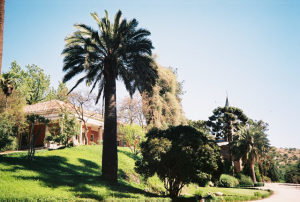
Santa Rita winery is surrounded by beautiful gardens
This is another “destination” winery with a magnificent park, flowering gardens, even a chapel. You will want to come here for the winery tour and lunch-offered daily from noon to 3-in the 200 year-old colonial house (wonderful ceilings and floor) housing the Do–a Paula Restaurant. Fabulous empanadas! Santa Rita is about an hour and a half from Santiago by easy driving via the Panamerica highway. As everywhere, please make a reservation, either by phone or by e-mail and make sure to identify yourself as an Epicurean Traveler reader.
I was especially impressed with Santa Rita’s most affordable range: the “120” line of wines, named after an historic event when 120 patriots in Chile’s 1814 War of Independence took refuge in Santa Rita’s cellars. The 2005 “120” Sauvignon Blanc is very fine for its $7 price: brisk and light with aimiable acidity; the 2005 “120” Rosé, is another $7 winner, showing
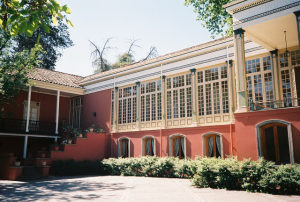
Santa Rita
amazing color and great “cab savviness” with the juice-all Cabernet Sauvignon grapes-spending 18 hours on their skins.
Another excellent value at $20 is the 2003 Medalla Real Cabernet Sauvignon with hearty black fruit, interesting tannins, and a delicate yet deep aroma. This Cabernet stands up well to the $50 top-of-the-range 2001 Casa Real Cabernet, a velvet monster from 40-year old vines with very limited per-acre yields. At $50 it should be exceptional; what struck me here, as at so many other wineries, was the quality of the lower-priced wines.
VERAMONTE
This large, beautifully run winery has been exporting to the US (“our largest market”) since 1998. [editor’s note: Veramonte is owned by famed renaissance-man Augustin Huneeus, one time head of Concha Y Toro, as well as Franciscan winery in Napa Valley, and current owner of Quintessa winery in Napa Valley]. Located in the Casablanca Valley about 45 minutes south of Santiago by car, Veramonte is open to visitors Monday through Friday 9:00 to 5:30, weekends and holidays 9:00 to 2:30. A tour of the winery plus tasting costs $3; a tasting without the tour is $2.00; for $10 you can enjoy a cheese and chocolate platter plus all of the above.
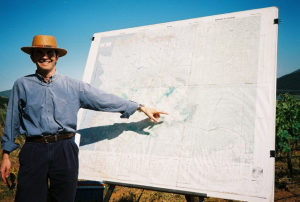
A map of the Vermonte property in Casablanca Valley
The climate and soil of Casablanca closely resemble those of Napa and Carneros with the telling difference that “a well-planted acre here costs about $40,000 while in Napa or Bordeaux it would cost $300,000. This is why Chile has been so well-positioned in the export market,” says Global Sales Director Carlos Kuscevic. In fact, most statistics show that Chile now ranks third in wine imports to the US!
For me Veramonte has the distinction of producing one of the very few Chardonnays I actually like. In fact, this one may turn out to be my all-time favorite: the 2003 Special Reserve from the Casablanca valley. Wowee! No malolactic on this tawny beauty, just the freshest, brightest fruit with excellent yeast integration and the lingering roundness of properly administered oak. Most of all, not a hint of the leaden weight that even very costly Chardonnays often display. This one is worth every penny of its $20 price.
Another stunner in this price category was the 2002 Cabernet Sauvignon Special Reservefrom the Maipo Valley. Deep and expansive, with an inviting sweetness and just a hint of mint over traditional Cabernet richness that lingered lovingly on the tongue. Dreamy!
CARMEN
One of the oldest wineries in Chile, Via Carmen was founded in 1850 and named after the founder’s wife. While Carmen produces the gamut of white and red varietals, it is primarily known as the first Chilean company to produce wines from organically grown grapes. Not usually a fan of either Chardonnay or organic wines, I nevertheless enjoyed the 2004 Carmen Nativa Chardonnay with its fleshy yet citrus-accented round notes-it was surprising to find such density in an organic wine-and for $15 at that. I also enjoyed the 2005 Rosé Cabernet Sauvignon which is a steal at $7. Fruity yet dry, this rosé has a lovely peach complexion, both in its color and basic fruit notes.
But my real favorite here (and one of my hot picks of the trip) is the 2000 Winemaker’s Reserve Red. This blend of 51% Cabernet Sauvignon, 27% Merlot, 10% Carmenère, 7% Syrah, and 5% Petite Syrah is quite simply black magic in a bottle. The tannins curve around, behind, under the intense black fruit which is accessorized with hints of mint, mocha, and truffle. It tastes like the proverbial “million bucks” yet costs only $40. This is one unique and complex wine. Loved it! Alas, Carmen is not open to visitors at this time but all of their wines are available in the U.S., as were all of the wines mentioned in this article at press time.
ERRÁZURIZ
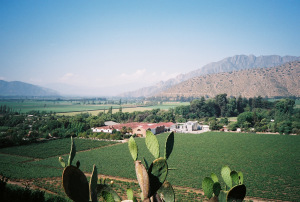
Errazuriz winery in Aconcagua Valley
Errázuriz, one of Chile’s oldest and most beautiful wineries, located in the Aconcagua Valley some hours north of Santiago, was just beginning to expand their main building to welcome visitors with greater ease. And Altair, a new French/Chilean venture (Dassault/San Pedro) promises to add a guest house to their architecturally intriguing winery in the Cachapoal Valley. Stay tuned for these and other promising additions when we explore the next phase of Chile’s emergence on the world wine scene and marvel once more at this long, lean land with its plush, lush reds and tight, tart whites.
& & &
